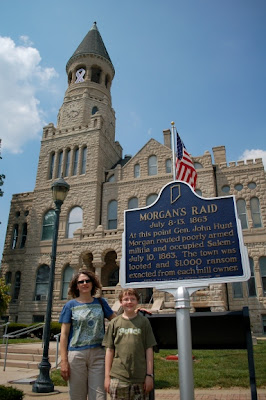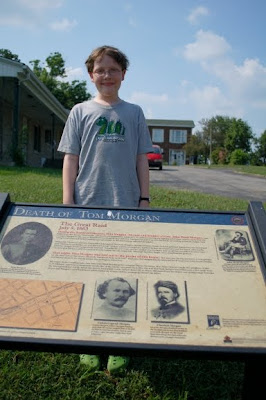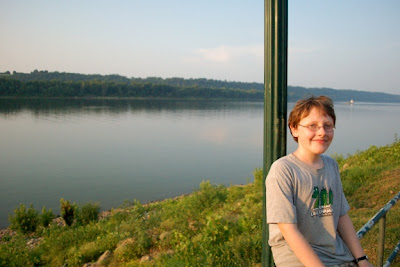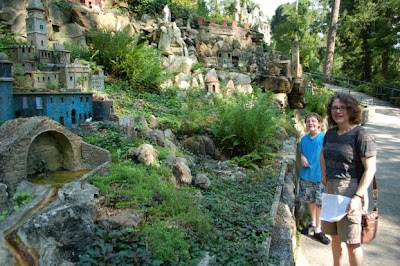
I'm sent to warn the neighbors, he's only
a mile behind;
He's sweeping up the horses, every horse
that he can find.
Morgan, Morgan, the raider, and Morgan's
terrible men,
With Bowie knives and pistols are galloping
up the glen.
Excerpt from the poem Kentucky Belle by Constance Fenimore Woolson
Two stragglers at Morvin's Landing (above) . . . where Morgan and his men disembarked on the Indiana shore. The buildings across the river mark Brandenburg, Kentucky. A couple of Indiana home guards were killed in action near here.

As Morgan and his men advanced towards Corydon, one of the raiders was shot and killed. Suspecting that the shot came from the Glenn home, the raiders retaliated by killing Peter Glenn and wounding his son.
This letter written by a 16-year-old girl conveys a local perspective of the Battle of Corydon much better than anything I can muster up:
Dear Cousin
. . . We have had rather exciting times in Indiana, for the last few weeks, and have had a few of the miseries of the south pictured to us though in a small degree. On the doubly memorable ninth of July a visit was paid to the citizens of Corydon and vicinity by Morgan and his herd of horse thieves. We heard Tuesday night that they had crossed the river and had disgraced the soil of Indiana with their most unhallowed feet. Our home guards skirmished with the rebs from the river to [Corydon] and on one of the hills overlooking the town had a grand battle. The battle raged violently for thirty minutes, just think of it! And on account of the large number of the rebs we were forced to retire which our men did in good earnest every one seemed determined to get out of town first but which succeeded remains undecided to this day. After the general skedaddle, Col Jordan wisely put up the white flag- and we were prisoners to a horde of thieves and murderers. I don't want you to think I am making fun of our brave home guards for I am not in the least. But now, that all the danger is over, it is real funny to think how our men did run. . . . It made Morgan so mad to think a few home guards dared to fight his men. I am glad they done it just to spite him. However they captured most of the guards and parolled them and killed three of our men. . . . One of our brave boys run three miles from the rebels, and really run himself to death. He stopped at a house and fainted and never came to. Didn't he deserve a promotion? I think that was the awfullest day I ever passed in my life. . . . The rebs were pretty hard on the copperheads but they did not take a thing from us. . . . I expect you are tired of hearing about Morgan so I will stop. I forgot my letter till so late this morning, and I have not got time to write much more or I will be too late for the stage so Goodbye.
Attia

If young Attia thought local response was lacking in Corydon, it was abysmal in Salem. After a close call with an old swivel gun used only in celebrations (it could have caused a good deal of devastation, as it was loaded with nails, slugs, chain, etc., but the young man in charge of lighting the fuse panicked), the raiders ran amok, burning, extorting the local mill owners, and looting. One raider rode out of town with seven pairs of ice skates draped around his neck!

After Salem, the raiders stopped in Canton and cleaned out this store (now called Fox's Country Store). There are benches in the store made from planks of the "Old Plank Road." Throughout the raid, George "Lightning" Ellsworth provided Morgan with critical information on the Union movements by tapping into the telegraph. Ellsworth stayed busy at several stops in this area . . . sending bogus, misleading messages and gleaning information about the whereabouts of their pursuers.
Dupont is the town that Conner Prairie Interactive History Park represents in its new exhibit about the John Hunt Morgan raid through Indiana. Scattered amongst several exhibit areas are a few fake hams representing the 2,000 hams that Morgan's men stole from the town.
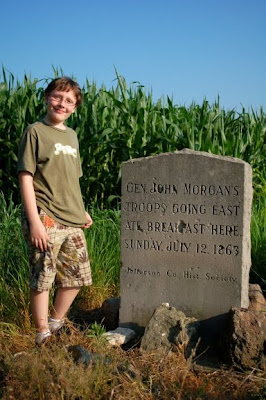
Our favorite Morgan monument (located southeast of Dupont) on the trip . . . "Gen. John Morgan's troops going east ate breakfast here Saturday, July 12, 1863."
Morgan's men arrived in New Alsace as mass was in progress at St. Paul's Catholic Church. I am fairly sure the raiders were pleased to see all of those horses gathered up for them in one place.

Across the street from St. Paul's are two more buildings from the time of Morgan's raid. Morgan slept in the building on the left, which at the time of the raid was the Jacob Gephart Saloon. And the building on the right was Tony Blettner's Tavern. Morgan located his headquarters here. You can reenact the raid at this point by going in and drinking a beer, as it is still a tavern.
Dover is a fine example of the extremes of the actions of the raiders. Just south of town Morgan's men happened upon a funeral procession for a young man who had just died. They forced them to switch the fresh horses pulling the hearse for a couple of "worn old nags." Counter this story with the image of raiders streaming bolts of stolen cloth behind them as they departed from Dover.

West Harrison, Indiana . . . just across State Street (left in the picture) is Harrison, Ohio. As the raiders moved on to Ohio, the men helped themselves to Indiana hospitality one last time. According to Lester Horwitz, one man was "observed to have a bird cage with three canaries, which he carried for three days."



